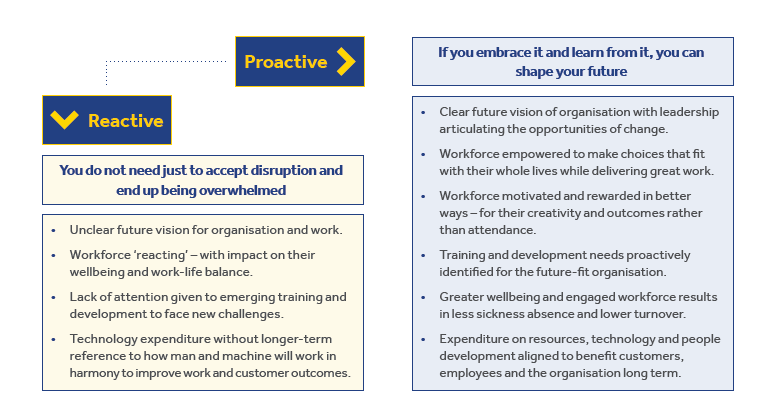Embracing the future of work – how can you lead the change?
Explore this article by Henley's Paul Lambert, who discusses what the drivers for change are and how you can use them as an opportunity to rise above the chaos of an uncertain market

Embracing the future of work – how can you lead the change?
The world is changing, and COVID-19 has exacerbated that change. Workforce transformation is difficult at any time and the pace quickens during a pandemic. And yet, armed with the right skills, this uncertainty also offers leaders opportunities to look beyond the ‘return to work’ and to purposely shape a workforce ‘fit for the future’.
What we already know – drivers of change
- More people are working remotely and want that to continue (especially in the UK): Morgan Stanley research (2020) reported that on average 71% of office workers believe that employers will allow regular work from home post COVID. This contrasts with an average of 27% people working from home in 2019.
- Automation is the old ‘new normal’ and it’s here to stay: People are increasingly comfortable with artificial intelligence applied in a ‘smart’ way to their lives, like Apple’s Siri app, which listens to your instructions, sending appropriate texts and executing relevant actions.
- Both work and workforce are becoming more flexible: The continued rise of the gig workforce, and the corresponding growth of internet platforms like Upwork, Toptal and TaskRabbit, both benefit and encourage a more flexible workforce. For leaders, not only does this result in greater pressure to offer the same flexibility but it also presents exciting opportunities for new ways to fill skills gaps.
- Mental health and wellbeing are priorities: Research from the Mental Health Foundation tells us that recently, around 50% of people felt anxious as a result of remote working. In addition to ensuring environments that are COVID safe, wellbeing considerations should take into account intelligence on how and where we work best.
Opportunity to step up and steer through the chaos
The disruption we are experiencing can be overwhelming and there is a strong desire among many of us to simply go back to how things were before the pandemic. But getting ‘back to normal’ isn’t necessarily the best business outcome. In fact, with so much up in the air, now is the best time for those positioned to influence the shape of the future organisation to step up, become a strategic leader and steer the organisation towards a better future.

Proactive thinking: How you can influence the future of work in your role
At Henley, we firmly believe that the human resources (HR) role should be that of a strategic adviser and change agent – and we can help you develop the skills to do this. In the following section, we share a taster of the questions we believe you will be asking as a strategic HR leader, and we look at answering some of those questions.
1. Who does the work? Man versus machine:
Broadly speaking, there are three options here: machines replace the ‘job’ completely (think self-checkouts in supermarkets); technology changes or improves how the work is done; or technology changes the work that can be done best by people. Whatever happens, the coming change represents vast and growing opportunities for technology to improve the way we work.
Keeping it human
There are some jobs, such as counselling, that are clearly best performed by human beings. But what of roles that are less obviously ‘human’? Even then there are human qualities that add value to our work and cannot be automated. As technology and automation takes on growing significance in the workforce, conversely so will the emphasis on using and building on human skills, such as innovation and emotional intelligence. So consider your organisation: Where are people needed, rather than a machine? And in your own role: How can your work be made more human? Will this change your role or career?
2. Where should work happen?
The framework below shows an insurance industry example, with potential for automation and remote working on the two axes of the chart. It shows claims processing, carried out remotely by machine, through to (financial) risk engineering, which needs to be facilitated in discussion with a physical client.

Does ‘the workplace’ exist?
COVID-19 has raised the question of where work is done; Should we race back to the office without questioning this instinct or considering the alternatives?
- BP announced the sale of its London HQ, citing that the pandemic had triggered a permanent shift in the way companies approach working patterns (City AM, 20 November 2020).
- Some organisations are revisiting the theory of the ‘third place’: neither home nor work (e.g. Starbucks). This is the idea of working from ‘corporate cottages’, which combine the tech and professional advantages of serviced offices with human factors such as a short commute, thus replicating the home-office environment while adding the opportunity of face-to-face meetings.
What are the resource needs of your organisation? Strategic leaders should be questioning the role of the physical office and what it means for the footprint of their organisation. Think about other workplace options, such as local hubs, 5G workspaces, remodelling existing space, effective homeworking, serviced office-spaces and so on.
Keeping it human
Here we return to human preferences and choices. As well as looking at the process by which work can happen, and where, we simply cannot do what we need to do in our organisations without good mental health. We know that where we work has a significant impact on us. Research carried out during the pandemic has shown how important this is when considering the future of the workplace:
- A Citrix survey (2021) of 1,000 UK office workers found that three quarters would take a pay cut to guarantee a fully remote role and better work–life balance.
- There have been reported house price rises in more rural locations as people choose to move out of cities (or indeed to homes with office space).
- On the other hand, while home working has seen an increase in productivity for many, others have struggled with sudden loneliness. It may be that the longer home working continues, the more significant this factor becomes in our new work culture.
- There isn’t a ‘one size fits all’ solution, but there are questions to ask in order to steer your organisation.
3. Who is your future workforce?
To recruit or not to recruit
As a strategic leader you will be part of reshaping the future workforce. In addition to new roles or automation, this will mean reconsidering the jobs that now have different requirements. Post-Brexit, someone managing orders from UK to the EU may find their roles have expanded from processing orders to roles of greater complexity, requiring negotiation skills, for example. A strategic leader would have to ask: Does the person in the role still have suitable skills?
Similarly, leaders will be considering if they need to ‘employ’ people in the same way. The gig economy means we can be increasingly creative about how we hire, including considerations about partners, ecosystems and platforms. Uber is an obvious example: their drivers don’t actually work for the company. Such considerations are now on the table for all organisations.
Training is a differentiator, and will meet the needs of an agile organisation
A recent study by Korn Ferry, shows that talent for a disruptive world needs learning agility (the capacity to adapt to change) as much as knowledge of technology. Organisations should be ready to identify skills gaps and to source training. This focus on personal growth and career development is vital, not just to combat high turnover, but in ensuring the workforce continues to be future-fit.
What are the next steps for you and your organisation?
The challenges have increased significantly for those with any involvement in workplace and workforce development. To enable you to step up and steer your organisation through this new and changing environment you will need access to the most up-to-date thinking, knowledge and ideas from the cutting edge of HR practice and research.
Henley’s People and Organisational Change masterclasses are specifically designed to help you navigate the increasing complexity and challenge of HR, strategic workforce planning and organisational development, and increase the impact that you can have on the future of your organisation.
With masterclasses on HR Business Partnership, Strategic Workforce Planning (SWP), and Organisational Development and Design, we offer rich, practical perspectives from industry experience, research and case studies covering:
- Trends in people and organisations
- The shifting role of HR
- New ways of undertaking talent and performance management
- The role of SWP and workforce analytics
- How to lead change and develop organisations
- The design of agile organisations, fit for a fast-moving environment



